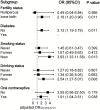Association between triglyceride-glucose index and risk of endometriosis in US population: results from the national health and nutrition examination survey (1999-2006)
- PMID: 38863936
- PMCID: PMC11165080
- DOI: 10.3389/fendo.2024.1371393
Association between triglyceride-glucose index and risk of endometriosis in US population: results from the national health and nutrition examination survey (1999-2006)
Abstract
Background and aims: The association of the triglyceride-glucose (TyG) index, a promising novel biomarker for insulin resistance, with the risk of endometriosis has not been investigated to date. This nationwide study aimed to explore the association between the TyG index and the endometriosis risk.
Methods: Data were obtained from the National Health and Nutrition Examination Survey (1999-2006). Female participants who provided complete data on the TyG index and endometriosis were enrolled in the analysis. Multivariate logistic regression analyses were utilized to assess the association of the TyG index with endometriosis, adjusted by multiple potential confounders. Meanwhile, in-depth subgroup analyses were conducted.
Results: A total of 1,590 eligible participants were included, among whom 135 (8.5%) women were diagnosed with endometriosis. The fully adjusted multivariate logistic model showed TyG index was significantly associated with the endometriosis risk (odds ratio [OR]Q4 versus Q1 2.04, 95% confidence interval [CI]: 1.15-3.62; P for trend=0.013). In subgroup analyses, the significantly positive association between TyG index and the risk of endometriosis was also found in parous women (ORQ4 versus Q1 2.18, 95% CI: 1.20-3.96), women without diabetes (OR Q4 versus Q1 2.12, 95% CI: 1.19-3.79), women who smoke currently (OR Q4 versus Q1 3.93, 95% CI: 1.33-11.58), women who drink currently (OR Q4 versus Q1 2.54, 95% CI: 1.27-5.07), and in women who use oral contraceptives (OR Q4 versus Q1 1.91, 95% CI: 1.04-3.51). Additionally, significantly increasing trends in the odds of endometriosis across the quartiles of the TyG index were observed in the above-mentioned subgroups (all P for trend<0.05).
Conclusions: This population-based study found that a higher TyG index, representing an increased level of insulin resistance, was associated with a higher risk of endometriosis among the US population. Our findings suggested TyG index might be a promising tool for the risk assessment of endometriosis. Prospective studies are warranted to further verify these findings.
Keywords: National Health and Nutrition Examination Survey; cross-sectional study; endometriosis; insulin resistance; triglyceride-glucose index.
Copyright © 2024 Liu, Wang, Ji, Kong, Pan, Xu, Geng and Miao.
Conflict of interest statement
The authors declare that the research was conducted in the absence of any commercial or financial relationships that could be construed as a potential conflict of interest.
Figures



References
MeSH terms
Substances
LinkOut - more resources
Full Text Sources
Medical

